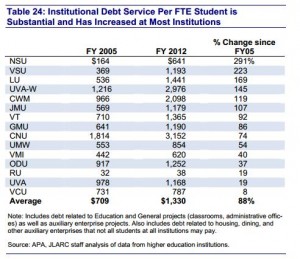 There are two broad conclusions worth noting from the Joint Legislative Audit and Review Commission’s meaty new report on higher education costs:
There are two broad conclusions worth noting from the Joint Legislative Audit and Review Commission’s meaty new report on higher education costs:
- Spending increases at public Virginia colleges and universities have been led by auxiliary enterprises, primarily athletic programs, not the academic programs funded by the state. Athletic programs consume on average 12% of tuition and fees.
- Virginia colleges have borrowed heavily to finance expansion of auxiliary facilities. Institutional debt now averages $1,330 per student, although the number varies widely between institutions.
The information could not be more timely, coming as it does on the heels of a plea from the Virginia Business Higher Education Council for more state funding. (See “University Coalition Bereft of New Thinking.”) Colleges routinely blame the decline in state funding for soaring tuition and fees.
While a decline in state financial support certainly contributed to the surge in the cost of college tuition and fees, JLARC concluded that the cost increases were greatest in “auxiliary enterprises,” a range of services that include intercollegiate athletics, student housing, student dining and campus recreation. In theory, these enterprises are expected to be self-supporting. In fact, they are increasingly supported by mandatory student fees. States the report:
Between 2001 and 2011, auxiliary enterprise spending (per student, adjusted for inflation) was the largest single contributor to spending increases at Virginia’s institutions. … As of 2011-12, 65% of the total price of higher education paid by a typical freshman student in Virginia was for non-academic services.
Running up the score. Athletic programs are among the worst offenders. “No Virginia program generates enough athletic revenue to cover all its expenses,” JLARC says. To supplement ticket sales, contributions and endowments, broadcast rights and royalties, universities depend upon mandatory student athletic fees. “Twelve percent on average of what Virginia students paid in tuition and fees in 2012-13 was for intercollegiate athletics.”
Virginia’s 15 higher education institutions collectively field 280 sports teams; the 6,100 students on those teams account for only three percent of all students. States JLARC:
Athletic spending at most Virginia schools has increased more than the NCAA divisional median rates of growth. … Students interviewed by JLARC staff stated that they would be willing to scale back athletics if that meant reducing the price to attend college. Although not common practice, some schools in Virginia and nationwide have decided to reduce or maintain the scope of their athletic program to keep costs down.
Another form of student debt. Virginia higher ed institutions have loaded up about $3.5 billion in debt on 207 auxiliary enterprises, according to JLARC. That debt, most of it for student housing, is funded by state-issued bonds, and the cost is passed on to students through higher fees, $1,330 on average, nearly double the level of of FY 2005. Institutional debt service averaged seven percent of total charges to students. Much of that debt was incurred to accommodate expanded enrollments.
A call for transparency. JLARC recommendations: (1) Colleges should post the amount of the athletic fee on their websites’ tuition and fees information pages; (2) universities also should devise a standard way of calculating and publishing their fees; and (3) university boards should charge directly for more student services in place of mandatory fees.




